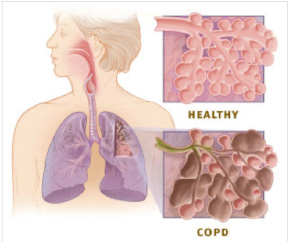Early Diagnosis
 Advance innovative research in the early pathogenesis and detection of tobacco-related diseases.
Advance innovative research in the early pathogenesis and detection of tobacco-related diseases.
The federal government and the commercial sector have invested substantial amounts in tobacco-related disease therapeutics, resulting in significant advances. TRDRP has played a key role in supporting the efforts of California researchers in this and related endeavors since it first started awarding grants in 1990.
The next generation of TRDRP disease research support will focus on early diagnosis and secondary prevention of tobacco-related cancers, chronic obstructive pulmonary disease (COPD), cardiovascular disease and nicotine addiction.
LUNG DISEASE
Smoking is responsible for between 80 and 90% of lung cancer deaths in the U.S. It is a risk factor for a number of other cancers including cancer of the oral cavity, larynx, esophagus, pharynx, pancreas and bladder. Smoking is also the major risk factor for Chronic Obstructive Lung Disease or COPD, the third leading cause of the death in the U.S. It is for these reasons that TRDRP considers the early detection of these diseases to be research priorities.
Read more about tobacco and lung disease American Lung Association and more about tobacco and cancer at the American Cancer Society.
Lung Cancer
Lung cancer is by far the leading cause of cancer-related mortality in the US with 159,390 deaths predicted for 2009. California can expect the second highest number of estimated new cases (17,910) in the US. Currently, 90 million current and former smokers are considered at high risk for lung cancer and the disease is expected to remain a global health problem for at least the next 50 years. Health care expenditures for lung cancer treatment and care are enormous - $10.3 billion in 2006 alone. A combined approach of early detection, smoking cessation and increased tobacco taxes could greatly alleviate the public health impact and economic cost of lung cancer.
Lung cancer diagnosis is almost invariably made after symptoms have appeared, at which point the cancer is frequently well-advanced and more difficult and expensive to treat successfully. If the tumor is caught early enough, the patient’s 5-year survival rate rises dramatically from 15% to 45%. Early detection is thus key to successful and cost-effective treatment. To date no specific biomarker or biomarker panel for the early detection of lung cancer is available for clinical diagnosis of early lung cancer, despite the clear need for such a tool in the management of this disease.
A need exists for transformative research to develop non-invasive methodologies that detect pre-clinical lung cancer. TRDRP’s Lung Cancer Early Detection Initiative was one step in this direction. It called for proposals on collaborative projects aimed at validating innovative technologies that have already been proven in principle to have the capability of detecting lung cancer in humans using non-invasive biological samples such as saliva, expired air, blood, serum or urine.

TRDRP Lung Cancer Early Detection Initiative Input Meeting
February 3, 2010
TRDRP funded two Integrated Research Projects as part of this initiative that will advance the field of early molecular diagnostics of lung cancer:
Integrated multi-omics approach to detect early lung cancer, Karen Kelly, Ph.D. (clinical lead); Suzanne Miyamoto, Ph.D. (technical lead) 20PT-0034.
Salivary Biomarkers Development for Detection of Lung Cancer, David Wong, Ph.D. (technical lead); Silverio Santiago, M.D., (clinical lead) 20PT-0032.
Chronic Obstructive Lung Disease (COPD)
Emphysema and chronic bronchitis are both diseases of the lungs that result from cigarette smoking. Both conditions have similar clinical manifestations (airflow obstruction and breathing difficulties) and frequently occur together; as a result, they are often referred to collectively as chronic obstructive pulmonary disease (COPD). They are, nonetheless, distinct diseases with distinct etiologies and pathologies. Emphysema is characterized by the destruction of lung tissue, enlargement of the alveolar spaces and, eventually, loss of elastic lung recoil. Chronic bronchitis results from inflammatory processes that result in cellular proliferation, mucus hyper secretion, and narrowing of the airways. Presently, there are no treatments that can prevent the progression of these conditions except for smoking cessation.
Cigarette smoking is the leading risk factor for the development of COPD and risk increases with the amount and duration of smoking. Abstaining from smoking and minimizing exposure to environmental tobacco smoke are the only effective ways to prevent COPD and the only avenue for alleviating its debilitating symptoms. Unfortunately, for those individuals diagnosed with COPD who have moderate to severe pulmonary dysfunction, the symptoms are essentially irreversible even if the patient quits smoking.
Understanding how smoking causes COPD can inform earlier diagnosis, more effective treatment, and some day even reversal of the disease process. TRDRP has begun support research that has the potential to advance science in this critical priority area:
Role for fibroblasts in the chronic immune response in COPD, Principal Investigator: Stephen Nishimura, M.D. 20XT-0132.
CARDIOVASCULAR DISEASE
Tobacco smoking and secondhand smoke (SHS) exposure have long been recognized as prominent risk factors for cardiovascular disease, the number-one killer in the U.S. How known and as-yet-unidentified toxicants in smoked and smokeless tobacco products increase the risk of cardiovascular disease is a promising area of research particularly in light of the FDA’s new responsibility to evaluate and regulate existing and emerging tobacco products due to the passage into law of the Family Smoking Prevention and Tobacco Control Act. TRDRP will continue to fund research on how smoking contributes to impaired circulatory function and the development of insulin resistance.
Smoking and Stroke
Epidemiological studies have identified tobacco use as a clinical risk factor for increasing the incidence of cardiovascular disease including cardiac arrest and stroke. The impeded flow of blood from a stroke starves the brain of oxygen, glucose, and other vital nutrients and this in turn activates signaling cascades within the cells of the brain resulting in ischemic injury and cell death. The role of protein kinase in regulating the balance between cell survival and death in brain cells is the focus of one TRDRP-funded study:
Role of PHLPP1 in Astrocytes and Stroke, Principle Investigator Nicole Purcell, Ph.D. 20KT-0048.
 NICOTINE ADDICTION
NICOTINE ADDICTION
Over 30 million people remain addicted to tobacco products generally and nicotine in particular. Understanding and blunting nicotine addiction remains critical to tobacco cessation efforts. As a result, TRDRP is prioritizing studies that will:
Lead to improving or identifying vaccines that can prevent the uptake of nicotine
Enhance our knowledge regarding the addictive potential and abuse liability of different tobacco products
Improve the efficacy and safety of Varenicline and/or develop more efficacious partial antagonists and partial agonists
Clarify the effects of long-term use of low dose nicotine products (patch, gum, etc.)
Expand our understanding of how to desensitize nicotine’s effects on smokers by interrupting the causal chain in nicotine addiction

